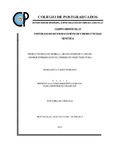| dc.contributor.author | Tadeo Robledo, Margarita | |
| dc.contributor.author | TADEO ROBLEDO, MARGARITA | |
| dc.creator | TADEO ROBLEDO, MARGARITA; 78039 | |
| dc.date.accessioned | 2018-09-26T17:58:19Z | |
| dc.date.available | 2018-09-26T17:58:19Z | |
| dc.date.issued | 2015 | |
| dc.identifier.uri | http://hdl.handle.net/10521/2923 | |
| dc.description | Tesis (Doctorado en Ciencias, especialista en Genética).- Colegio de Postgraduados, 2015. | es_MX |
| dc.description.abstract | En esta investigación se planteó como objetivo definir la capacidad productiva de tres híbridos de maíz (Zea mays L.), entre ellos Tsíri PUMA, en sus versiones androestéril y fértil, y determinar la mejor proporción de mezcla de semilla androestéril (AE) y fértil (F), en dos fechas de siembra. Para ello, se establecieron dos experimentos en el ciclo primavera-verano 2012 en la Facultad de Estudios Superiores Cuautitlán (FESC-UNAM), empleándose un diseño experimental de bloques completos al azar con tres repeticiones. Las fuentes de variación fueron fechas de siembra, híbridos, proporciones de semilla androestéril y fértil (0-100; 20-80; 40-60; 60-40; 80-20; 100-0) y sus interacciones. El rendimiento no tuvo diferencias significativas entre fechas de siembra, pero la comparación de medias entre genotipos detectó que el híbrido Tsíri PUMA (8,989 kg ha-1) fue estadísticamente superior en rendimiento a H-47 AE (8,190 kg ha-1). La comparación de medias (Tukey, 0.05 de probabilidad) entre las proporciones de semilla androestéril y fértil, considerando la media de los tres genotipos evaluados y las dos fechas de siembra, detectó dos grupos de significancia, donde los dos mejores rendimientos fueron 100 % androestéril 0 % fértil (9,441 kg ha-1) y 80% androestéril + 20% fértil (9,390 kg ha-1). Debido a que la versión con sólo semilla androestéril no es prácticamente factible, una opción adecuada es la proporción 80:20, que optimiza el esquema por usar menor cantidad de jornales, pues requiere una fracción de 20% de semilla fértil. La proporción 100% semilla fértil tuvo el menor rendimiento (8,116 kg ha-1). _______________ PRODUCTIVITY OF THREE MAIZE HYBRIDS UNDER DIFFERENT PROPORTIONS OF MALE-STERILE AND FERTILE SEED. ABSTRACT: The objective of this research was to know the yield performance of three hybrids of maize (Zea mays L.), including Tsíri PUMA, in its male sterile and fertile versions, and also to determine the best mixing proportions of male-sterile (MS) and fertile (F) seeds, in two planting dates. Thus, two experiments were established at the School of Higher Studies Cuautitlán (FESC-UNAM) in the season spring/summer 2012, and a randomized complete block design with three replications was used. The sources of variation were planting dates, hybrids, male sterile and fertile seed proportions (0-100; 20-80; 40-60, 60-40, 80-20; 100-0) and their interactions. The yield was not significantly different between planting dates, but the comparison of means between genotypes detected that hybrid Tsíri PUMA 1 (8,989 kg ha-1) yielded statistically more than H-47 AE (8,190 kg ha-1). The comparison of means (Tukey, 0.05 probability) between the proportions of male sterile and fertile seed, considering the average of the three genotypes and the two planting dates, detected two groups of significance, where the two best yielding genotypes were those of 100% male sterile:0% fertile (9,441 kg ha-1) and 80% male sterile:20% fertile (9,390 kg ha-1) seed proportions. Because the version with only male sterile seed is not a practical feasible option, an appropriate choice is that of 80:20, which optimizes the production schema by needing less labor and requiring only a fraction of 20% of fertile seed. The proportion of 100% fertile seed had the lowest yield (8,116 kg ha-1) among all seed proportions. | es_MX |
| dc.format | pdf | es_MX |
| dc.language.iso | spa | es_MX |
| dc.rights.uri | http://creativecommons.org/licenses/by-nc-nd/4.0 | es_MX |
| dc.subject | Genética | es_MX |
| dc.subject | Doctorado | es_MX |
| dc.subject.classification | CIENCIAS AGROPECUARIAS Y BIOTECNOLOGÍA::CIENCIAS AGRARIAS::AGRONOMÍA::SEMILLAS | es_MX |
| dc.title | Productividad de semilla, grano, forraje y uso de androesterilidad en el híbrido de maíz Tsíri Puma. | es_MX |
| dc.type | Tesis | es_MX |
| Tesis.contributor.advisor | García Zavala, J. Jesús | |
| Tesis.contributor.advisor | Espinosa Calderón, Alejandro | |
| Tesis.contributor.advisor | Lobato Ortíz, Ricardo | |
| Tesis.contributor.advisor | Gómez Montiel, Noel Orlando | |
| Tesis.contributor.advisor | Sierra Macías, Mauro | |
| Tesis.contributor.advisor | Valdivia Bernal, Roberto | |
| Tesis.date.submitted | 2015 | |
| Tesis.date.accesioned | 2016 | |
| Tesis.date.available | 2016 | |
| Tesis.type | Tesis | es_MX |
| Tesis.format.mimetype | pdf | es_MX |
| Tesis.format.extent | 2,723 KB | es_MX |
| Tesis.subject.nal | Productividad de semillas | es_MX |
| Tesis.subject.nal | Seed productivity | es_MX |
| Tesis.subject.nal | Zea mays L. | es_MX |
| Tesis.subject.nal | Fecha de siembra | es_MX |
| Tesis.subject.nal | Sowing date | es_MX |
| Tesis.subject.nal | Calidad del forraje | es_MX |
| Tesis.subject.nal | Forage quality | es_MX |
| Tesis.subject.nal | Rancho Almaraz, Cuautitlán Ixcalli, Estado de México, México | es_MX |
| Tesis.rights | Acceso abierto | es_MX |
| Articulos.subject.classification | Maíz híbrido-calidad | es_MX |
| dc.type.conacyt | doctoralThesis | es_MX |
| dc.identificator | 6||31||3103||310311 | es_MX |
| dc.contributor.director | GARCIA ZAVALA, J. JESUS; 36087 | |
| dc.audience | generalPublic | es_MX |


